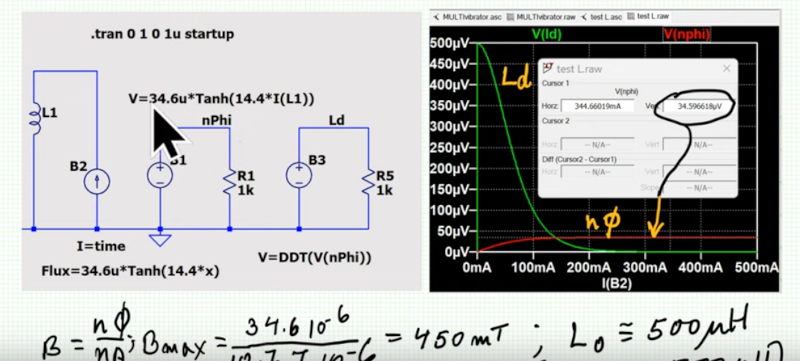LTSpice and the underlying Spice engine does a great job of simulating ideal components. But it is also capable — if you know how — of handling models of real-world devices. Inductors, for example, are one of the most imperfect components. Their constituent wire has resistance, and there is parasitic capacitance between the windings. If there is a core, it also will have many imperfections and losses. [Sam Ben-Yaakov] has a lecture about modeling real inductors in LTSpice, and he covers how you can capture some of these imperfections in the video below.
There is a bit of math in the presentation, but we liked that it relates back to datasheets for actual components. Being able to understand what the parameters on a datasheet mean is crucial, and if you ever wondered what some of these entries mean, you’ll get a lot from this video.
The main feature of the model is the flux equation. The tanh (hyperbolic tangent) function is similar to the curve you want for the flux equation, so it plays a major part. Of course, there are other parts of the inductor you may have to model, too, but this is one of the most difficult parts.
You can also model transformers using LTSpice. You can also create custom components.
















So an inductor has flux and has capacitance. What happens at 88MPH?
That’s when you dump in 1.21 Gigawatts, and stand back.
Jigawatts
Cool fact: a “capacitor” in a magnetic equivalent circuit… is just a resistor in the outer circuit. (That is, I = C dV/dt Phi = C’ d(NI)/dt. Hm.. negative resistor, specifically?)
> There is a bit of math in the presentation, but
That’s not something a presentation should have to apologize for. Jeez.
I totally agree … but It does in today’s world …. unfortunately. From what I’ve heard being taught/ not taught in our schools we are heading for a world of idiocracy …
Al, thanks for the presentation and article.
Pedant alert:
It is LTspice, not LTSpice.
https://www.analog.com/en/design-center/design-tools-and-calculators/ltspice-simulator.html
I’m fond of using a stock model including saturation and core loss:
https://www.seventransistorlabs.com/Modeling/SPICE/INDSAT.ckt
Choose parameters for the core and turns as needed.
I’ve also made more bespoke models for ferrite beads:
https://www.seventransistorlabs.com/Modeling/SPICE/MI1206L391R_NL.ckt
a particularly interesting case as many people are unaware of saturation in ferrite beads. (Or in type 2 ceramic capacitors!)
Coilcraft give LTspice models now (presumably, working well in transient? I haven’t tried yet), but if using other simulators, or just making your own if you have impedance data to curve-fit:
https://www.seventransistorlabs.com/Calc/Coilcraft1.html
this is a handy way to do that.